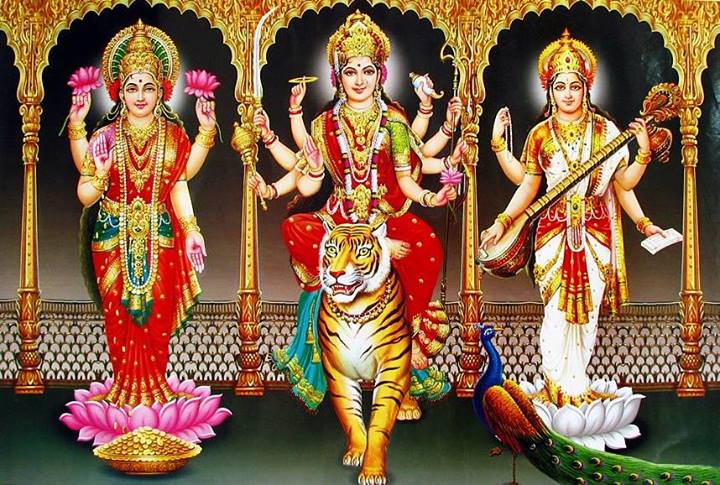Devi, the female aspect of God, is energy or ‘shakti’. Everything in this world is made of energy. “Ya Devi sarva bhuteshu, shakti rupena sansthitaa.” Everything is vibrating at different frequencies. Everyone is born into this world of energy, which is also a world of duality. In this world, there are five factors operating: space, time, causation, name and form.
We are told that to go to the Father, we must go through the Mother. What is implied by this, according to Shaivism-Shaktism, is that we have to go through the world of energy to reach Paramshiva, that Supreme state of non-differentiation and the substratum of existence. It is essential in our journey to this ultimate state that we rise beyond, transcending this world of energy.
There is a picture of Lord Shiva, lying on the ground, with Maha Kaali standing on him, one foot on his stomach and one foot on the ground. This is a powerful symbol of Shiva, the substratum, and the energy and dynamism of Paraashakti, projected out of him. Shiva remains unchangeable, unconditional, non-differentiated; this is the ultimate objective of our spiritual quest. From Him everything emerges, and into Him everything returns. Vedanta says that this world is false; Shaivism-Shaktism says you have to go through this world of energy to find Paramshiva. In Vedanta, maya is the delusive potency of the Lord; in Shaivism-Shaktism, it is the illusion of individuality, which prevents us from identifying with the All, the principle of aham brahmasmi.
The different aspects of energy are represented by the goddesses – Durga, Lakshmi, Saraswati, Kaali. They represent the personification of different powers or energies that exist. Without them, we couldn’t function or even survive. Why do we worship these forms? Because humans think in terms of images. We cannot conceptualise that which is formless; so, the sages, to satisfy our limitations have given us these symbols, the different forms of Devi. If we understand and identify with this concept, it will be a catalyst to take us further along the journey. So when we say that the mother takes us to the father, the journey begins. Devi Ma takes us back to that Supreme state of oneness with the Divine.
In order to tap into this power, we must make the intellectual effort. “Ya Devi sarva bhuteshu, buddhi rupena sansthitaa.” Even the intellect within the body is shakti. As Adi Shankara has said, “Aatma twam girija mati”: “O Shiva, you are aatma, the soul.” Girija shakti is mati, which means the intellect. There are three states of the intellect: the unenlightened intellect, the relative intellect and the enlightened intellect. Shiva is the unchanging; it is the intellect that changes. We live in a state of unenlightenment in that we gravitate towards materialism or maya shakti. We need to move towards chid shakti or the state of enlightenment. In-between these states is the relative intellect.
To put it simply, great minds think of principles; mediocre minds think of events and low minds think of people. We have to analyse the state of the mind. Do we get caught up in people and events or do we try to understand the underlying philosophy of events and the behaviour of people? This transformation has to take place internally. We have to analyse and understand the philosophy and principle and that is pure shakti. When we reach that state, then we can identify with Shiva.
There is a rationale behind all the various festivals that we celebrate, Nau Raatri, Ram Naumi and so forth; they not only exist for social or psychological reasons but they also have a very strong philosophical basis. The journey is to rise beyond the state of ignorance to a state of enlightenment. Let the intellect undergo a transformation to a state of enlightenment. It is only then that Parbatee can identify with Shiva. Paraashakti takes us to Paramshiva. Then we can merge in oneness with the Supreme Lord.
From a discourse by Paramacharya Pt. Hardeo Persad



